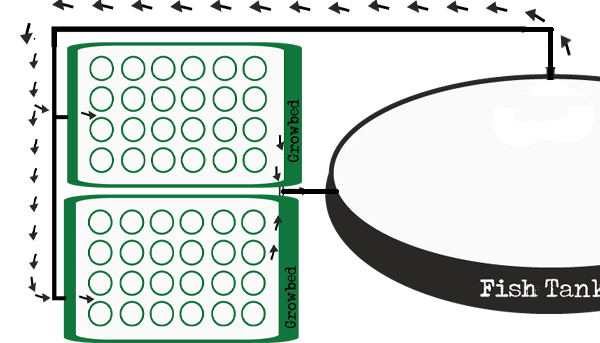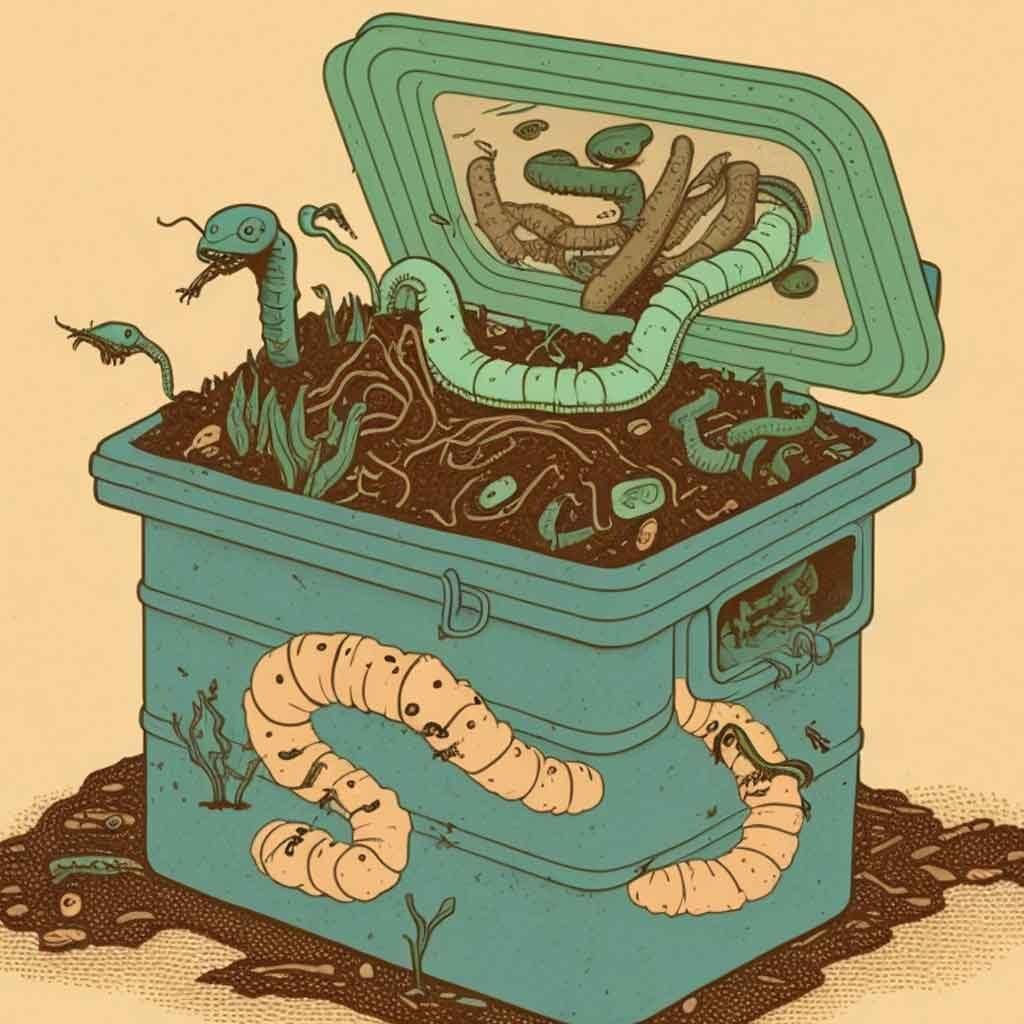Drip systems are commonly used in gardening around the world. The concept is simply provide the needed amount of water directly to the plants roots. The drip system was able to revive gardening and farming in areas where water is scarce because of its controlled water wise system. Aquaponic farmers have adopted the drip system for a number of reasons, however controlling the exact flow of water and distributing it equally throughout a grow bed has to be one of the leading priorities of using such a system.

The diagram above shows a simplified version of a drip system used in aquaponic farming. The black spots represent where the plants are places. The nutrient rich fish water is pumped from the fish tanks to the manifolds sitting at the top of the grow bed. Holes are then drilled into the manifolds and small tubing spickets are inserted into these holes and secured with glue into place. Drip tubes cut into the desired lengths are then pushed onto the spickets and placed in the grow medium next to each plant.
The system pumps are operated by a timer which turns them on and off at your desired period of time, pumping water to the plants and then allowing the cleaned water to return to the fish tank via the gravity feed system.
These innovative, eco-friendly setups are changing the game for green thumbs everywhere. In this comprehensive guide, we’ll uncover the secrets to building and maintaining an aquaponics drip system, so you can enjoy fresh, homegrown produce any time of the year. Ready to get your hands dirty? Let’s get started!
I. The Magic of Aquaponics Drip Systems
A. What is an Aquaponics Drip System?
Aquaponics drip systems are a sustainable gardening method that combines the best of hydroponics and aquaculture. It’s a match made in horticultural heaven! These systems use fish waste as a natural fertilizer for plants, while plants clean the water for the fish. Add in a drip irrigation system to deliver water and nutrients directly to the plants’ roots, and you’ve got yourself a powerhouse of eco-friendly growing.
B. Why Choose an Aquaponics Drip System?
- Resource Conservation
- Water-efficient: Save H2O and money on your water bill.
- Energy-efficient: Less electricity required compared to other methods.
- Space-efficient: Grow more in less space.
- Chemical-Free Growing
- No synthetic fertilizers or pesticides needed.
- Healthier, tastier produce.
- Year-Round Harvest
- Grow fresh produce any time of the year, even in colder climates.
II. Setting Up Your Aquaponics Drip System
A. Choosing the Right Components
- Fish Tank
- Size matters: Bigger is usually better.
- Material: Choose from glass, acrylic, or fiberglass.
- Grow Bed
- Material: Food-grade plastic or fiberglass.
- Depth: Aim for 12-18 inches.
- Plumbing and Pumps
- Water pump: Submersible or external.
- Air pump: Keep those fish happy and healthy!
- PVC pipes and fittings: The backbone of your drip system.
B. Finding the Perfect Balance
- Fish Selection
- Hardy species: Tilapia, catfish, and trout are popular choices.
- Legalities: Check local regulations before stocking your tank.
- Plant Selection
- Leafy greens: Lettuce, kale, and spinach thrive in aquaponics.
- Herbs: Mint, basil, and cilantro are flavorful options.
III. Maintaining Your Aquaponics Drip System
A. Feeding Your Fish – Quality food: Choose high-quality fish feed for healthy fish and plants. – Feeding schedule: Consistency is key.
B. Monitoring Water Quality – Regular testing: Keep an eye on pH, ammonia, nitrite, and nitrate levels. – Adjustments: Learn how to tweak your system to maintain balance.
C. Pruning and Harvesting – Keep it trim: Prune plants regularly for optimal growth. – Harvest time: Enjoy the fruits (and veggies) of
your labor: Pick produce when it’s ripe and ready to eat.
IV. Troubleshooting Common Aquaponics Drip System Issues
A. Plant Problems
- Yellowing Leaves
- Nutrient deficiency: Check for adequate nutrient levels.
- pH imbalance: Adjust pH to the optimal range for your plants.
- Wilting or Stunted Growth
- Root rot: Ensure proper aeration and water flow.
- Pests: Introduce natural predators or use organic pest control methods.
B. Fish Troubles
- Sick or Dying Fish
- Water quality: Test and adjust water parameters as needed.
- Disease: Quarantine and treat affected fish promptly.
- Poor Fish Growth
- Overcrowding: Maintain a proper fish-to-plant ratio.
- Nutrition: Feed your fish a balanced diet.
V. Aquaponics Drip Systems FAQs
Q: How much does it cost to set up an aquaponics drip system?
A: The initial investment varies depending on the size and complexity of your system. Expect to spend a few hundred dollars for a small-scale setup, while larger systems can cost thousands.
Q: Can I use any type of fish in my aquaponics drip system?
A: No, not all fish species are suitable for aquaponics. Choose hardy fish that can tolerate fluctuating water conditions and have a high waste-to-biomass conversion rate.
Q: Is it possible to grow fruiting plants like tomatoes or peppers in an aquaponics drip system?
A: Yes, it is possible to grow fruiting plants in an aquaponics drip system. However, they require more care and attention to ensure adequate nutrient levels and support structures.
With a little bit of elbow grease and some know-how, you’ll be on your way to enjoying fresh, chemical-free produce from your very own aquaponics drip system. So, roll up your sleeves, grab your gardening tools, and let’s get growing!
For more information I would check out DIY Aquaponics



